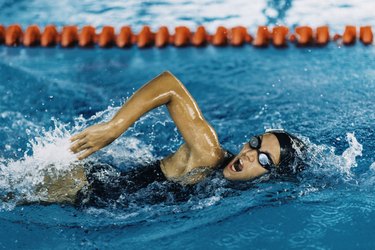
Do you think you could outswim a shark? In 2017, 28-time Olympic medalist Michael Phelps donned a monofin and pitted his mad swim skills against those of hammerhead and great white sharks.
Although Phelps reached a max speed of 8.8 miles per hour — 87 percent faster than his fastest world record, according to Ultimate Swim Fin, the official distributor of the Lunocet Pro Monofin worn by Phelps — the average swimming speed of the sharks won the race.
Video of the Day
Video of the Day
Tip
Although Michael Phelps can reach 8.8 miles per hour wearing a monofin, the fastest unassisted human swimmers reach speeds of 5 to 6 miles per hour over short distances.
Know the Water Conditions
How fast a human can swim not only depends on fitness; it depends on water conditions also. Swimming in a pool that is temperature-controlled and free from forces of nature such as waves and currents will naturally produce faster swim times. It's also easy to veer off course in open water when there aren't lane lines to keep you in check.
Read more: 7 Tips to Become a Better Swimmer
Competition pools in the U.S. average 78 F to 80 F, according to the United States Water Fitness Association. That's ideal for the fastest national swimmers, such as Josh Schneider, to swim at speeds of up to 5.3 miles per hour in the controlled conditions for short distances. The Olympic requirements for competition range from 77 F to 82 F according to the Federation Internationale de Natation (FINA) the ideal for optimal human performance.
However, if other people use your local pool for other purposes than competitive swimming, it's likely much warmer according to the association, which recommends water temperatures of 83 F to 94 F for arthritic or young swimmers. Water below 77 F starts to affect your breathing and average swim speed; water at 70 F or below is dangerous to swim in without a wetsuit per the National Center for Cold Water Safety.
Environment and Average Swimming Speed
Schneider's national record of 19.36 seconds in the 50 freestyle took place in a 25-yard pool. Put the same swimmer in a 50-meter pool and his time slows to 21.78 seconds or 5.1 miles per hour. The reason is partly because 50 yards equals roughly 46 meters. But his powerful underwater acceleration off the wall in the middle of the short-course swim also helps rocket his speed by 0.2 miles per hour.
Read more: The Ultimate Body-Weight Beach Workout
Open water swimming will slow you down not just because you don't have any turns to boost your speed. The fastest woman to swim a mile in a 50-meter pool is Luane Rowe, whose national record of 17:22.39 minutes (a speed of roughly 3.5 miles per hour) stands since 2012 according to U.S. Masters Swimming.
Conversely, it takes swimmer Abigail Nunn 20:02.38 minutes (3 miles per hour, approximately) to complete a mile swimming alongside a cable in open water.
Swim Faster at Race Pace
If you want to increase your own speed and spend less time in the pool, try training at race pace. Known formally as Ultra Short Race Pace Training (USRPT), the technique pioneered by Professor Emeritus Brent S. Rushall of San Diego State University involves training the body to swim at a maximum speed over short distances.
The brain "codes" the faster swim into its neurology, effectively training it to move at max speed. When the goal is swimming fast, training your body to plod along at a slow rate over a long distance is counterproductive.
Break your fastest swim time for your target event into chunks. For example, divide your fastest 100-meter freestyle time by four to set a target time for 25-meter repetitions. Your goal is to meet this target time for a set number of repetitions with a specific 15- to 20-second rest interval between them before you "fail out" by your body being unable to maintain the race pace velocity.
Join a swim club specializing in USRPT or enroll in remote sessions to work with coaches trained in this cutting-edge technique to improve your average swimming speed. Clubs in the U.S. currently offering USRPT training include the Race Pace Club in California or Sedona Race Pace Club in Arizona.
- Ocean Conservancy: "5 Ocean Animals That are Faster than Michael Phelps"
- U.S. Masters Swimming: "Long Distance Records"
- U.S. Masters Swimming: "Pool USMS Records"
- Ultimate Swim Fin: "Discovery Channel's Shark Week - Uproar Over Michael Phelps' Race With a CGI Shark"
- Ultimate Swim Fin: "Lunocet Pro Monofin"
- United States Water Fitness Association: "Suggested Swimming Pool Temperatures"
- Federation Internationale de Natation: "FINA Facilities Rules"
- National Center for Cold Water Safety: "What Is Cold Water?"
- San Diego State University: "Step-by-Step USRPT Planning and Decision Making Processes"
- Federation Internationale de Natation: "Michael Andrew Explains His Unique Training System"
- USRPT: "Mini-Guide to USRPT"
- Team Unify: "Race Pace Swimming"
- Sedona Race Pace Club: "Home"
- Eventbrite: "Race Pace Club Events"
- Race Pace Revolution: "Courses"